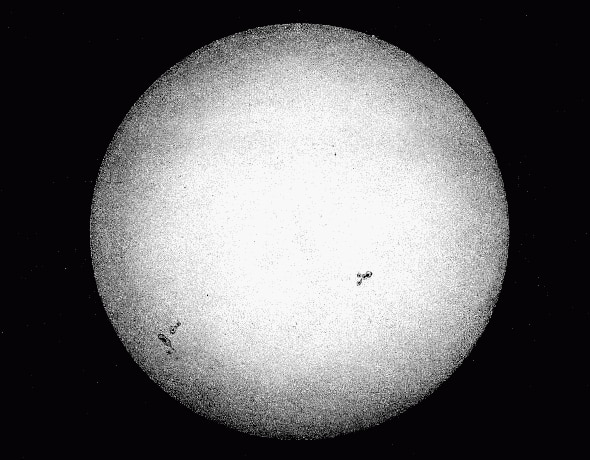Create a free profile to get unlimited access to exclusive videos, sweepstakes, and more!
The First Photo of the Sun

I was doodling about on the internet reading about various astronomical topics—as I do sometimes, and I highly recommend it—and stumbled upon an interesting fact: The first photograph of the Sun was taken on April 2, 1845.
The photo, shown above, was made by French physicists Hippolyte Fizeau and Léon Foucault. They used a daguerreotype, what was really the first kind of photography; a metal plate was treated with chemicals that made it light-sensitive, exposed to a scene, then treated with different chemicals to stop the exposure.
That vintage photo of the Sun shows our star’s relatively sharp edge as well as a handful of sunspots. The spots are pretty big, roughly as wide as Jupiter (for comparison, the Sun is 1.4 million kilometers across).
I was pretty surprised to see the date, though. Why? Because this came five years after the first photograph of the Moon!
The exact date of the first lunar photo is unclear (many attempts were made, with varying results, and apparently some were mislabeled) but chemist John Draper announced he had made the accomplishment on March 23, 1840. At least one photo from around that date still exist, so the claim is probably acceptable.
I would naïvely think the Sun’s portrait would be taken before the Moon’s, since it’s brighter and therefore shorter exposures were necessary. But in fact that may have been the issue; remember, this was more than 170 years ago, and the mechanism to take a very short exposure may have been difficult to create. It’s far easier to take, say, a two or three second exposure than one that’s a fraction of a second if you lack the engineering to make the latter. The solar photograph above had an exposure time of 1/60th of a second.
Once the two brightest objects in the sky were captured on photographic plates, though, fainter ones followed. Although I’ve seen different dates listed, it’s generally accepted that on Sept. 30, 1880, astronomer Henry Draper (John’s son) took the first photograph of the iconic Orion Nebula. How far we’ve come—the same photo can be taken easily and in moments using a phone cam held up to a small telescope.
I dabbled in astrophotography when I was in high school (I rolled my own Tri-X film and developed it in my bathroom, for those of you who speak 20th-century photography nerd), and that led to a somewhat meandering path to eventually working on processing images from the Hubble Space Telescope, and calibrating a camera launched into space and placed in the venerable observatory in 1997. Even now I still love it when I can get a decent shot of an astronomical object with my own equipment.
What progress we’ve made since the 1800s! Professional observatories peering deep into the Universe, and “amateur” astronomers create jaw-dropping and scientifically interesting images. It’s thrilling, and it never stops being thrilling.
I tip my lens cap and dew shield to Fizeau, Foucault, Drapers 1 and 2, and all the others who pioneered this field. They may not have realized what they started, and that, nearly two centuries later, their work would still be known, respected, and recognized as one of the most important scientific advances in history.


























